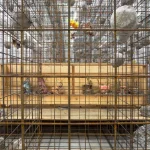My comment piece on the Marina Abramović retrospective at the Royal Academy of Arts, London, for the Telegraph
Celebrated as a secular saint, the artist’s hollow brand of ‘shocking’ performance art only reveals that we are desperate for meaning
Watching visitors squeezing bashfully between the naked young man and woman standing guard, either side of the gallery doorway in Marina Abramović’s Royal Academy exhibition, should provoke some sense of transgression. That it doesn’t – a few awkward smiles, a general good natured indifference around – tells you something about how tame such “performance” art has become.
Just as Abramović has acquired the status of international art star in the last decade or so, her London retrospective tells us something about the price of that celebrity – how a style of extreme, dissenting art that once saw itself as confrontational, even radical, has finally become the darling of mainstream galleries. And how Abramović has morphed into the high priestess of a very contemporary fusion of experiential art and victim culture, offering her own brand of communion, between the audience and the almost saint-like figure of “the artist”.
As the naked pair put up with the jostling and rubbing with stoic calm (they’ve been trained, by Abramović, in her “method”), the extremes of endurance that have become Abramović’s hallmark are projected all around, on huge screens or caught in black-and-white photographs: Abramović lying back and screaming at the top of her lungs until she loses her voice; pictures of Abramović agitated by the effects of taking anti-catatonic drugs, then lolling unconscious after taking anti-schizophrenics; Abramović and her then-partner Ulay leaning away from each other, a bow and arrow held taut between them, Ulay straining not to release the arrow he’s pointing at her chest.
Pushing yourself to extremes of endurance and subjecting yourself to danger has always had a sacrificial tinge in Abramović’s work. That the iconography of martyrdom is present shouldn’t be surprising. While she grew up in secular communist Yugoslavia, her grandmother took her to Orthodox Christian church every Sunday, and it’s impossible not to get a whiff of that medieval Christianity, given a feminist tilt, in her early performances, such as that stage in Naples in 1974 – the provocative confrontational vulnerability of Rhythm 0, in which Abramović gave herself up to an audience to do with her as they wished, encouraged to use objects laid out on a table, things that might hurt and others that might give pleasure. Abramović ended up stripped to the waist, scrawled on, bleeding from a cut to her neck, and – so the story goes – a loaded gun put in her hand and pointed at her neck.
The history of performance art is freighted with such uses and abuses of the body, and Abramović has – by sheer persistence, if nothing else – become that genre’s contemporary figurehead, though like many performance artists of the 1970s, she was really following in the footsteps of pioneers such as Japan’s Yoko Ono or American Carolee Schneemann. These were 1960s artists who made their “happenings” happen long before the term “performance art” had been invented: Rhythm 0, after all, came a decade after Ono’s Cut Piece – in which Ono sat impassively as audience members were invited to cut away at her clothes with scissors.
But by the gloomy, angry 1970s, a more downbeat and politically confrontational performance art was emerging – the blood-soaked cattle-entrail-strewn “orgies” of the Austrian Hermann Nitsch, or the gruelling self-deprivations of the British artist Stuart Brisley. Going beyond yourself, ditching your staid, conformist sense of individuality, pretended to political seriousness.
But if that caustic, confrontational edginess gave Abramović’s work a sense of urgency to an artworld looking for radicalism, even as it became more established and more accepted through the 1980s and 90s, her work has blown with the prevailing cultural wind. From the confrontational feminist politics of the 1970s, Abramović’s work shifted to the more personalised, emotionally intimate world of her collaborative works with Ulay, male-female antagonisms that picked up the fashion for psychoanalytic theory in the 80s.
But having parted ways with Ulay in 1988 (after each having walked 2,000 km from either end of China’s Great Wall, to meet in the middle, only then to break up with him), Abramović as a solo artist was rediscovered in the contemporary art boom of the 90s, and her work since has leant ever more heavily on a mix of mysticism and esotericism, tapping into a cultural zeitgeist that’s more about connecting rather than confronting.
Sealing Abramović’s art-celebrity status was 2010’s marathon The Artist is Present, where she sat across a table for eight hours a day for three months, holding the gaze of whichever audience member sat opposite her. A thousand people queued for this experience. At the Royal Academy, we get to watch an ever-changing video-projection mosaic of faces on one side, each facing its own Abramović who stares back at them from the opposite wall.
Communion? Catharsis? The release of pent-up sadness in regret before this benign maternal figure? Whatever it is, it’s clear by watching it that some people, really, really want to believe
Other celebrities turn up – there’s Antony Gormley, Alan Rickman, Miranda Richardson – and we watch as in the brightly lit gallery, the more millennial visitors get emotional – catching sobs, tears streaming down cheeks. Communion? Catharsis? The release of pent-up sadness in regret before this benign maternal figure?
Whatever it is, it’s clear by watching it that some people, really, really want to believe. In a society in which people feel more isolated, more anxious, more convinced of their own fragility – in this age of vulnerability, there’s a peculiar thirst for therapy and transcendence, and Abramović offers both; not in the privacy of the confessional or the analyst’s office, but in the glare of the gallery’s public forum. It has weird echoes of the female mystics of medieval Europe – the huge banner that hangs over the Academy’s courtyard has Abramović in various expressions of madness and rapture.
Abramović’s 21st century mysticism is a hotchpotch of Eastern spirituality, Buddhism, ascetic Christianity, paganism and, when you get to the more recent work, crystals and semi-precious stones, channelling whatever “energy” it is that the gallery texts insist the artist believes in. There are people standing with their foreheads against polished stone headrests mounted on the walls. There is a huge bisected amethyst geode, and a “gateway” glowing with illuminated crystals through which one walks, and baths full of dried flowers over which more crystals are suspended. By this point, you wonder if Ambramović isn’t actually lampooning the A-list woo-woo she seems immersed in, like Madonna in her bath with her candles. But if so, none of her fans seem to have got the memo.
For them, doubtless, Abramović is a brave prophet of better ways of being, her saint-like aura out of the endurance of self-administered suffering, a virtuous warrior against injustice. This messianic egoism infects the hype. Much of the show’s press has repeated the assertion (which seems to have slipped out of Abramović’s recent Guardian interview), that she is the first female artist to be honoured with a solo show in the Academy’s 255-year history; prompting a flurry of comment pieces railing against our engrained culture of sexism.
The trouble is, it’s not really true. Admittedly, the RA isn’t, historically, the most progressive institution for gender balance, its monographic shows a long list of men, dotted with very few women. But the first major retrospective of a living female artist was British sculptor Elisabeth Frink’s, in 1985. Frink was even offered the presidency of the Academy. (She declined, explaining that she was just too busy making sculpture.)
But why let facts get in the way of a hot take? Abramović has even been made special ambassador to Ukraine, a do-gooding celebrity-as-saviour; like Bono, but for the art world. That’s what ends up happening when the artist becomes a celebrity, shaped by a culture’s need for a figure onto which it might project its desire for redemption – an increasingly empty spectacle, of fake feeling and manufactured togetherness, with the art gallery turned into a shrine.



